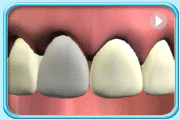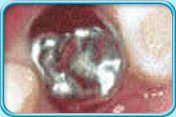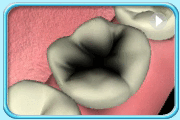Crown
A crown refers to the placement of an artificial crown on a tooth. It acts as a 'cap' that fits over the tooth which mimics a real crown of tooth.
Purpose
- To restore the original shape and function of teeth.
- To improve the esthetics of teeth, such as shape, size and colour.
- To fix a bridge onto the teeth.
A fixed bridge is supported by crowns on either/both side.
- To protect teeth from fracture.
Tooth that has undergone root canal therapy and with a large filling is more brittle. It can be protected from fracture when a crown is placed.
Materials
-
Metal alloy
Properties
- Durable.
- High wear resistance.
- Metal alloy crown can be quite thin --- only a small amount of tooth substance needs to be removed to accommodate it.
Disadvantage
- Metallic colour, poor esthetics.
Application
- Used at high stress bearing area where good esthetics is not a must. For example, posterior teeth.
-
Procedures for metal alloy crown.
- Remove a thin layer of tooth substance on all surfaces of the crown.
- Take impressions of the upper and lower teeth and record the bite. Construct a temporary crown to protect the prepared tooth.
- Fabricate the metal alloy crown in the dental laboratory.
- Remove the temporary crown and clean the tooth surface.
- Cement the crown onto the tooth.
Porcelain fused to metal
Properties
- Esthetic --- colour of outer surface is similar to natural tooth.
- Strong and durable because of the metal alloy base.
- Hard.
Disadvantage:
- Relatively more tooth substance needs to be removed from the facial surface of the tooth.
Application
- Used on anterior teeth.
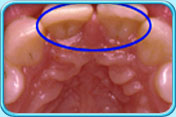 Before treatment.
Before treatment.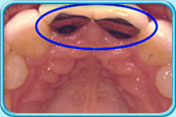 After treatment.
After treatment.
Procedures for porcelain fused to metal crown
- A thin layer of the tooth is removed.
- Take impressions of the upper and lower teeth and record the bite. Construct a temporary crown to protect the prepared tooth.
- Fabricate the porcelain fused to metal crown in the dental laboratory.
- Remove the temporary crown and clean the tooth surface.
- Cement the crown onto the tooth.
-
Stainless steel
Properties
- Stainless steel crown is not custom-made. It is preformed into certain sizes.
- Since the crown is not custom-made, the procedures of fitting are simple and the time taken is relatively short.
Disadvantages
- Silvery colour, unesthetic.
- Non-stress bearing, not lasting.
- Causes tooth decay and gum disease easily --- since the crown margin is not closely adapted to the tooth, the margin is prone to accumulation of dental plaque.
Application
- Used on molars of deciduous teeth.
- As temporary crown before the permanent crown is ready for use.
Procedures for stainless steel crown.
- Remove a thin layer of the tooth surface structure.
- Choose the right size stainless steel crown and try it in the tooth.
- Trim the crown according to the contour of the tooth.
- Clean the tooth surface.
- Cement the crown onto the tooth.
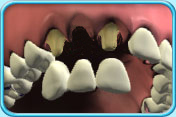
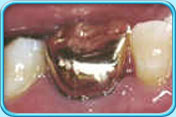
 Before treatment.
Before treatment. After treatment.
After treatment.